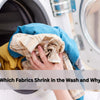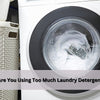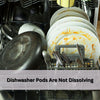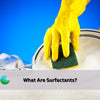Ocean Plastic Pollution: Solutions for a Cleaner Ocean
- by Brodie Cook

- Approximately 20 million metric tons of plastic litter end up in the environment annually. ¹
- Plastic pollution affects all land, freshwater, and marine ecosystems. ¹
- By 2050, plastic is expected to outweigh all the fish in the sea. ²
- There are between 50-75 trillion pieces of plastic and microplastics in the ocean. ²
- Plastic pollution costs the global economy up to $19 billion USD per year. ²
- Over 400 million metric tons of plastic are produced every year. ³
- The Great Pacific Garbage Patch is the largest accumulation of ocean plastic, estimated to be twice the size of Texas. ³
- Only 12% of plastic was recycled in 2020, while the rest is either incinerated or ends up in the environment. ⁴
- Marine life, including 86% of sea turtle species and 44% of seabird species, are impacted by plastic pollution. ⁵
Now these are some shocking facts! In this blog post, we're going to talk about the importance of how ocean plastic pollution poses a real-world problem.
What are the main sources of plastic pollution in our oceans?

Plastic pollution mainly comes from single-use plastics, industrial waste, and improper waste management. Items like plastic bags, bottles, and packaging are used once and then thrown away, creating a lot of waste.
Factories produce plastic waste during the manufacturing process. This includes not only large plastic items but also small plastic pellets known as nurdles. Nurdles are the raw material used to create plastic products. These tiny pellets often spill during transport or production, and because they are small and lightweight, they easily escape into the environment, contributing significantly to plastic pollution.
Inadequate waste collection systems lead to plastics being dumped in landfills or directly into the environment.
Microplastics are another major source. These tiny particles come from cosmetics, synthetic clothing, and degraded larger plastic items. They end up in water bodies and the food chain.
The fishing industry also adds to this problem. Abandoned or lost fishing gear, like nets and lines, pollutes the oceans, a phenomenon known as "ghost fishing."
Tourism, recreational activities, household waste, and marine activities contribute too. Beaches and oceans near tourist spots suffer from littering. Every day plastic items from homes add to the pollutant load when not disposed of correctly. Ships and boats release plastics through waste disposal, cargo spills, and lost containers. Reducing single-use plastics and improving waste management can help fight plastic pollution.
How do plastic bags and single-use plastics contribute to ocean plastic pollution?
Plastic bags and single-use plastics, like straws and bottles, are major culprits. They are used briefly but can last for hundreds of years in the environment. These items are lightweight and easily carried by wind and water, ending up in the ocean.
Once in the ocean, they break down into microplastics, which are harmful to marine life that mistake them for food and ingest them. Some of these plastics also entangle animals, causing injury or death.
How much plastic is in our oceans?
How much plastic waste is generated every year?
Each year, the world produces over 400 million metric tons of plastic waste. The packaging sector is the largest contributor, responsible for about 40% of this waste.
The textile industry, with synthetic fabrics, and agriculture, using plastics for mulch films and seed coatings, are also significant contributors to plastic pollution. Mulch films are thin plastic sheets spread over the soil in farming to retain moisture, reduce weed growth, and regulate soil temperature. Seed coatings are thin layers of plastic or other materials applied to seeds to protect them from pests, diseases, and harsh environmental conditions, and sometimes to include nutrients for better germination. However, when not properly managed, both mulch films and seed coatings contribute to the growing problem of plastic waste in the environment. 6
What is the scale of floating plastic in the Great Pacific Garbage Patch?
The Great Pacific Garbage Patch (GPGP) is the largest accumulation of ocean plastic in the world, located between Hawaii and California. It is estimated to contain around 100,000,000 kilograms (100,000 metric tons) of plastic. The concentration levels vary, with the highest densities reaching hundreds of kilograms per square kilometre in the centre, decreasing towards the edges.
Plastic gets to the Great Pacific Garbage Patch through a combination of ocean currents, rivers, wind, and human activities. The North Pacific Subtropical Gyre plays a key role. This system of circulating ocean currents acts like a vortex, pulling in plastic debris from the coastal waters of North America and Asia. Rivers carry plastic waste from inland areas to the ocean. Wind and weather patterns blow lightweight plastics into the ocean, while stormwater runoff adds more debris.
What impact does plastic pollution have on corals?

We already mentioned before in this blog about how plastic pollution impacts fish and other marine life. But let's talk about our reefs and corals. Corals are crucial to marine ecosystems. They provide habitat and shelter for many marine organisms. Reefs protect coastlines from erosion and support the fishing and tourism industries. Healthy coral reefs are vital for ocean biodiversity.
Plastic pollution poses a significant threat to corals and reefs. It stays on top of shallow ocean water where coral reefs are located, heating the water and causing coral bleaching. When coral bleaches, it turns white and becomes weak, making it more susceptible to disease, which can kill it. Plastics can also block sunlight, which corals need for photosynthesis. Without enough sunlight, corals can bleach and die. 7

Plastics can also introduce pathogens to coral reefs. Corals in contact with plastic have an increased risk of disease. The presence of plastic can cause abrasions and injuries to corals, making them more vulnerable to infections.
Toxins from degrading plastics can leach into the water, stressing corals and disrupting their growth and reproduction. These effects weaken coral reefs, making them less resilient to other threats like climate change.
Reducing plastic waste and improving waste management can help protect our coral reefs. Cleaning up existing ocean plastic is also essential to preserve these vital ecosystems for future generations.
How does plastic debris disrupt the food chain?
Plastic debris disrupts the food chain by being ingested by marine life. Small plastics, known as microplastics, are consumed by plankton and fish at the base of the food chain. These plastics contain toxins that accumulate in higher concentrations as larger predators eat the smaller creatures. This process, called biomagnification, leads to increased toxin levels in larger marine animals.
Humans are also impacted by this disruption. Consuming seafood contaminated with microplastics can affect human health. I don't want to go into the exact details of this, but this just tells us how the effects of plastic pollution ripple through the food chain, ultimately affecting us as well!
What measures can be taken to reduce plastic production and use?
Reducing plastic production and use can be achieved through simple actions in daily life. Here are some effective measures:
-
Use Reusable Bags and Containers: Bring cloth bags for shopping and use glass or metal containers for storing food. This reduces the need for single-use plastic bags and containers.
-
Avoid Single-Use Plastics: Choose products with minimal or no plastic packaging. Opt for alternatives like paper, glass, or metal packaging. Say no to plastic straws, utensils, and bottles, and use reusable alternatives instead.
-
Recycle Properly: Rinse out containers before recycling and sort them according to local recycling guidelines. Learn what can and cannot be recycled in your area to ensure plastics are processed properly and do not end up in landfills or the ocean.
-
Support Plastic Bans and Policies: Back policies that reduce plastic waste. Support bans on single-use plastics and plastic bag fees. Advocate for incentives to use reusable items.
-
Choose Sustainable Products: Opt for items made from biodegradable or recycled materials. Support companies with eco-friendly packaging and production methods.
-
Participate in Clean-Up Activities: Join local clean-up efforts for beaches, rivers, and parks. Help reduce existing plastic pollution and raise awareness about the importance of keeping the environment clean.
Final thoughts on ocean plastic pollution
Everyone can make a difference by taking small steps to reduce plastic use. Using reusable products, supporting eco-friendly brands, and participating in local cleanups can all help. Every action counts in the fight against plastic pollution.
Small steps can greatly impact the battle against ocean plastic pollution. Opting for reusable items over disposable plastic can significantly reduce the amount of plastic that reaches the ocean. Brands like Lucent Globe offer alternatives such as laundry and dishwashing sheets, which help minimise the production of plastic products. Participating in local cleanups also helps retrieve plastic debris from beaches and waterways, preventing it from entering the marine environment and harming marine species.
By addressing plastic pollution on a personal level, everyone can contribute to the solution. Reducing plastic usage, supporting waste management systems, and choosing eco-friendly products are crucial actions. These efforts help manage plastic waste, prevent plastic waste from entering rivers, and ultimately stop plastic pollution from affecting our marine environment. Each step, no matter how small, helps tackle this problem and protects the world's oceans and marine life.
References:
Image Source with the unhealthy coral from Ecodive Bali
¹ Center for Biological Diversity: Ocean Plastics Pollution
² UNESCO Intergovernmental Oceanographic Commission: Ocean plastic pollution an overview: data and statistics
³ The Ocean Cleanup: Ocean Plastic Pollution Explained
⁴ Lucent Globe: Why is Eco-Friendly Packaging Important?
⁵ Clean Water Action: The Problem of Marine Plastic Pollution
6 PDF by Plastic Overshoot Day , 2023
7 University of Nebraska - Lincoln Plastic Pollution's affect on coral reefs, 2022
Pewtrusts: Our Ocean is Choking on Plastic - But It's a Problem We can Solve

 Dishwashing
Dishwashing Laundry
Laundry Bundles
Bundles Toilet
Toilet



